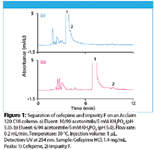Assaying the Concentration of Cefepime by HPLC with UV Detection
The Application Notebook
Development of cephalosporin antibiotics has led to compounds with a broad spectrum of activity against both Gram-positive and Gram-negative bacteria with low toxicity profiles. Cefepime, a fourth-generation cephalosporin, is a commonly prescribed broad spectrum antibiotic with improved activity against Gram-negative bacteria compared to other commercially available cephalosporins (1). Despite extensive research on this class of drugs, quantitative analysis and purity assays remain problematic (2).
Development of cephalosporin antibiotics has led to compounds with a broad spectrum of activity against both Gram-positive and Gram-negative bacteria with low toxicity profiles. Cefepime, a fourth-generation cephalosporin, is a commonly prescribed broad spectrum antibiotic with improved activity against Gram-negative bacteria compared to other commercially available cephalosporins (1). Despite extensive research on this class of drugs, quantitative analysis and purity assays remain problematic (2).
The EP and USP have published methods to assay cefepime and determine the related compounds (3,4). (Detailed information on related compounds methods has previously been published and will not be discussed here (5).) The USP assay uses a pentanesulfonate/acetonitrile eluent at a high flow rate of 2.0 mL/min, compared to a phosphate/acetonitrile eluent at 1.0 mL/min described in the EP assay. The EP method is convenient in that it uses the same column and solutions for the assay and related compounds methods, while the USP method uses two different columns and different eluents for each method.
The Acclaim® 120 C18, 3 μm can be used to meet and exceed the criteria set by the USP for assaying cefepime while using eluents suitable for a related compounds method. The efficiency of this column allows for short run times without sacrificing resolution, leading to high-throughput, high-resolution methods. The lower flow rate used with this column saves time and resources due to less frequent eluent preparation, and produces less waste compared to the original EP and USP methods.
Experimental
A Dionex UltiMate® 3000 system with a DGP-3600M pump, a FLM-3100 flow manager (a TCC-3200 column compartment would be equivalent), a WPS-3000T autosampler, and a VWD-3400 detector was used in this work. An Acclaim 120 C18, 3 μm analytical column (2.1 × 150 mm) was used for all separations with the conditions shown in Figure 1. Dionex Chromeleon® Chromatography Management Software was used for system control and data processing.

Figure 1
Results and Discussion
An isocratic method for assaying cefepime was tested for linearity, LOQ, LOD, and precision. Both 10% acetonitrile in 5 mM monobasic potassium phosphate, as specified in the EP method, and 6% acetonitrile in 5 mM monobasic potassium phosphate were tested as eluents. The retention time for cefepime using an eluent of 10% acetonitrile in phosphate buffer is 3.6 min (Figure 1a). However, an impurity peak, described by the EP as impurity F, is present in the tail of the peak. Using an eluent of 6% acetonitrile in phosphate buffer provides improved resolution, moving the impurity away from the cefepime peak, which now has a 7.0 min retention time (Figure 1b). The linearity, LOQ, LOD, and precision data for both eluents are listed in Table I. In both cases, the linearity and precision are excellent and both methods are shorter than or equivalent to the current USP method while meeting USP criteria for the assay method.

Table I: Linearity, precision, LOD, and LOQ for the isocratic cefepime assay method
References
(1) Yahav, D.; Paul, M.; Fraser, A.; Sarid, N.; Leibovici, L. Efficacy and Safety of Cefepime: A Systematic Review and Meta-Analysis. Lancet Infect Dis. 2007, 7, 338–348.
(2) El-Shaboury, S.R.; Saleh, G.A.; Mohamed, F.A., Rageh, A.H. Analysis of Cephalosporin Antibiotics. J. Pharm. Biomed. Anal. 2007, 45, 1–19.
(3) The United States Pharmacopeia 30, Supplement 1, NF 25, American Pharmaceutical Association, Washington, DC, 2007.
(4) The European Pharmacopeia, fourth ed., Council of Europe, 2002.
(5) Dionex Corporation. Determination of Cefepime and Cefepime-Related Substances Using HPLC with UV Detection. Application Note 205, LPN 2081, Sunnyvale, CA, 2008.
Acclaim, Chromeleon, and UltiMate are registered trademarks of Dionex Corporation.
Dionex Corporation
1228 Titan Way, P.O. Box 3603, Sunnyvale, CA 94088-3603
tel. (408)737-0700, fax (408)730-9403
Website: www.dionex.com

Pick Your Poison. Isolation of Paclitaxel (Mar 2025)
March 7th 2025The diterpenoid, paclitaxel, which was identified as a potent chemotherapy agent for breast and ovarian cancer originates from the Pacific Yew tree. The isolation of paclitaxel from its major impurities is shown with the use of Hamilton’s PRP-1 (5 µm) HPLC column.

.png&w=3840&q=75)

.png&w=3840&q=75)



.png&w=3840&q=75)



.png&w=3840&q=75)














